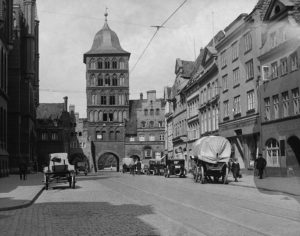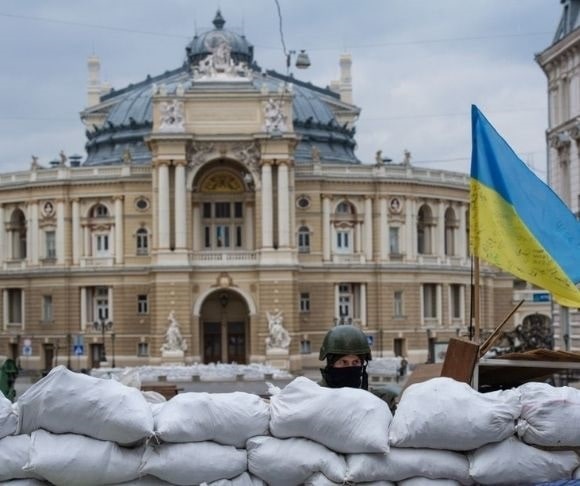In one of the more inglorious moments in World War II, England and Germany engaged in a series of raids on culturally-rich cities that served as highly dubious military targets at best. Who started it is still debated today, but both sides freely indulged in the destruction. Today, the Ukrainian city Odessa (or Odesa) – a place of cultural significance to both Russians and Ukrainians – could be in peril of the same destruction.

Castle gate Hanseatic League town of Lubeck (Photo by © Hulton-Deutsch Collection/CORBIS/Corbis via Getty Images)
In early 1942, the Royal Air Force bombed the old medieval Hanseatic League town of Lubeck, which was “[m]ainly built of dry old wood, and essentially undefended,” artist and author Jonathon Keats writes in his 2013 book Forged: Why Fakes Are The Great Art Of Our Age. “Two hundred and thirty-four planes dropped nearly three hundred tons of incendiary bombs, burning thousands of homes, as well as the merchant’s quarter, the town hall, and several historic churches renowned throughout Europe for their Gothic architecture.”
The Germans decided on a tit-for-tat response. “[T]he Luftwaffe retaliated with the so-called Baedeker Blitz, vowing to obliterate every town with a three-star rating in Baedeker’s Guide to Great Britain,” Keats continues. English cultural targets in militarily unimportant locales such as Bath, Canterbury, and Norwich were bombed.
Eighty years later, it remains a shameful affair all around.
Cultural Jewel, Military Target
In Ukraine today, a city of vast cultural treasure is being threatened by war, but there are a couple of twists. First, Odessa is a vital seaport town on the Black Sea and thus a first-class military target. But unlike Winston Churchill or Adolf Hitler, Russian President Vladimir Putin would not be destroying merely prized Ukrainian cultural artifacts if he chooses to bomb the city into submission. Odessa has deep historical significance to Russia as well.

Odessa, Ukraine (Photo by Scott Peterson/Getty Images)
Odessa serves as prime propaganda material for Western-backed Ukraine and Eastern-oriented Putin. As a cosmopolitan city with a diverse multi-cultural population, it makes a perfect vehicle for Western narratives on a “modern” democratic Ukraine.
On the Russian side, essential components of great national feeling abound.
Odessa was founded by famed czarina Catherine the Great in 1794. “When it was part of Russia, it was the fourth most important city in the [Russian Empire] (after Moscow, St. Petersburg, and Warsaw),” travel guide Fodors notes. It still contains a Russian-speaking majority among its population of one million residents.
In historical terms, the city offers the same magical appeal to Greater Russian proponents that California and The Old West provided to eastern seaboard Americans in the 1800s.
The website Hidden Europe states:
“The secret to understanding Odesa, a city created from almost nothing in 1794, is an appreciation of Muscovy’s relationship with the Black Sea. It was Catherine the Great who decreed that just where the steppe falls down to the sea, a great port and imperial city should arise. So, on the dry bluffs, Odesa developed and became one of the great cities of the Tsarist Empire – an elegant town of boulevards shaded by chestnuts and acacia trees, of Italianate palaces which in their ornamental extravagance rivalled even those of St Petersburg.”
Many celebrated Russians lived in Odessa for a time, including the novelist Alexander Chekhov and Aleksandr Pushkin, who is revered as the nation’s greatest poet. His impact on Russian literature and language is often equated with that of Shakespeare for speakers of English.
There are statues to Catherine and Pushkin in Odessa today. It would surely be painful for any Russian leader to blast them to smithereens.
The Potemkin Steps
Odessa was also the site of a key event in the premature 1905 Russian revolution. Sailors of the battleship Potemkin staged a mutiny in Odessa. It was bloodily suppressed, with 2,000 Odessans dying during the struggle as well.
The incident served as a lynchpin of communist propaganda when the Soviets took control of Russia. In 1925, director Sergei Eisenstein was commissioned by the still-new Red regime to make a movie commemorating the rebellion. Battleship Potemkin is considered today to be one of the most influential films ever made.
 Eisenstein filmed a crucial scene at the Odessa Steps, which are today otherwise known as the Potemkin Steps. It is still celebrated for its groundbreaking nature 97 years later. If you remember the 1980s film The Untouchables, its scene of the baby in the carriage falling down the steps is taken directly from the Odessa Steps scene in Battleship Potemkin. For Putin to turn the very steps immortalized by Eisenstein into rubble would be another shocking sight for many Russians.
Eisenstein filmed a crucial scene at the Odessa Steps, which are today otherwise known as the Potemkin Steps. It is still celebrated for its groundbreaking nature 97 years later. If you remember the 1980s film The Untouchables, its scene of the baby in the carriage falling down the steps is taken directly from the Odessa Steps scene in Battleship Potemkin. For Putin to turn the very steps immortalized by Eisenstein into rubble would be another shocking sight for many Russians.
Ukrainian President Volodymyr Zelensky has repeatedly warned that Russia is poised to bomb Odessa. “It will be a war crime… a historical crime,” he declared March 6. The problems for Putin go beyond propaganda fallout, however. Severely damaging or destroying a city of such vast cultural resonance to the Russian people is undoubtedly not a task that he would relish going down in history for performing.
~ Read more from Joe Schaeffer.




